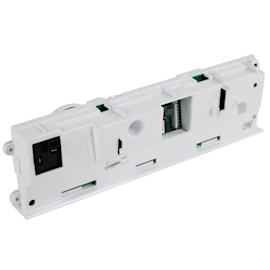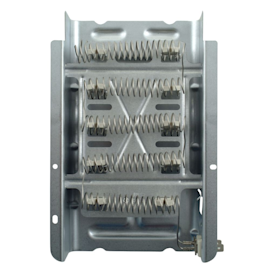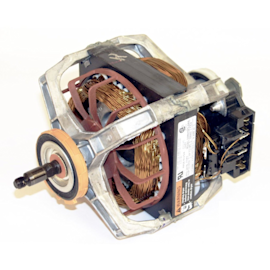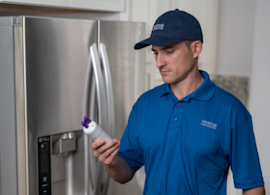- Kenmore refrigerator water filters
- Whirlpool refrigerator water filters
- Samsung refrigerator water filters
- GE refrigerator water filters
- LG refrigerator water filters
- Frigidaire refrigerator water filters
- KitchenAid refrigerator water filters
- Maytag refrigerator water filters
- Kenmore Elite refrigerator water filters
- Estate refrigerator water filters
- GE Profile refrigerator water filters
- Amana refrigerator water filters
- Bosch refrigerator water filters
- Dacor refrigerator water filters
- Electrolux refrigerator water filters
What are the main parts of a clothes dryer?


You likely don’t think much about the internal parts of your clothes dryer—until it breaks and you need to figure out which part to replace.
Dryers are fairly simple appliances. They tumble and heat your clothes to dry them. Dryers typically use an electric heating element or a gas burner to heat air that dries the clothes. Some components such as the drive motor and drum belt are common to both gas and electric dryers and some parts are unique to each type of dryer.
Read on to learn more about the major parts of clothes dryers.
Dryer drive motor
The drive motor rotates the motor shaft, which in turn rotates the idler pulley, which rotates the drive belt that's wrapped around the dryer drum. The motion of these components rotates the drum. The drive motor also rotates the blower fan blade on most dryers, which exhausts hot air from the dryer.
Dryer drum
The dryer drum is a metal or plastic cylinder that rotates during the drying cycle to circulate air around the garments. Hot air enters the dryer drum through one end and exhausts through the other end of the drum. Baffles inside the spinning drum catch and tumble the clothes. The drum is open on both ends in some clothes dryers, while it’s open on one end and perforated on the other in some models.
Drum drive belt
The drive belt wraps around the dryer drum and connects to the drive motor pulley and the idler pulley. The idler pulley maintains the proper tension on the belt. The drive motor rotates the drive pulley, which in turn rotates the dryer drum.
Drum support rollers
The support rollers hold the drum in place in the dryer cabinet while allowing the drum to rotate on the roller support wheels. The drum support rollers are on shafts attached to the bottom of the inside back panel and the inside front panel or bulkhead of the dryer. The drum support rollers are often sold in a kit that includes support rollers and shafts.
Blower fan blade
The blower fan blade is a turbine-shaped fan blade that rotates on the end of the motor shaft opposite from the drive pulley that rotates the drive belt. The fan blade blows exhaust air from the dryer.
Dryer control
Some dryers use an electro-mechanical timer while other use an electronic control board to govern dryer functions such as driver motor operation and heater operation.
Dryer electronic control board. The electronic control board is the circuit board that governs the timing and execution of functions in the dryer. It sends voltage to the drive motor and other components during the cycle. It senses the temperature in the drum and cycles the heating element on and off to maintain the proper temperature.
Dryer timer. The timer on the control panel enables the user to set the drying time by turning the timer's control knob. A small motor on the back of the timer advances the timer during the cycle. The timer's internal cams open and close switches or contacts to operate the various electro-mechanical components in the dryer (mainly the drive motor and the heating element).
Door switch
The dryer door switch recognizes whether the door is open or closed. The dryer won't start unless the door switch senses that the dryer door is closed. The door switch also turns on and off the drum light on models with a light.
Heating element
The electric dryer heating element is a coil or other arrangement of wire in which an electric current produces heat to dry clothing.
Gas burner assembly
The gas burner ignites to produce heat to dry clothing. The burner assembly uses these components to help control its operation:
Burner igniter. The igniter in a gas clothes dryer glows white hot until it reaches the ignition temperature, at which point the flame sensor opens electrically to divert current flow in the electrical circuit to the gas valve coils. The gas valves open, and the burner lights.
Flame sensor. The flame sensor detects when the igniter is hot enough to light the gas burner. When the igniter is hot enough, the flame sensor shuts off current to the igniter and current then flows through the gas valve coils, which open the gas valves to light the burner.
Gas valve coils. The gas valve coils control gas flow going to the gas burner assembly. When the proper electrical current is applied to these solenoid coils, they open the gas valves for ignition and continued heating of the dryer.
Thermostats, fuses and sensors
Dryers use thermostats, fuses and sensors to help control functions. Fuses are safety devices that prevent the dryer from running or overheating. Thermostats help control dryer heating or shut off the heating system when the dryer overheats. Sensors detect conditions and help the control system operate the dryer safely and efficiently.
Dryers have these specific types of thermostats, fuses and sensors:
Operating thermostat. The operating thermostat—also called the cycling thermostat—senses the air temperature inside the dryer drum. It cycles the heating element in an electric dryer and the burner is a gas dryer, turning the heat on and off to maintain the temperature at about 150 degrees Fahrenheit for the Normal setting.
High-limit safety thermostat. The high-limit safety thermostat shuts off the heat when the dryer overheats either because the operating thermostat fails or the heating element has a short circuit. The high-limit safety thermostat resets when the dryer cools.
Thermal fuse. The thermal fuse is usually mounted on the blower fan housing. It detects the temperature of the air venting from the dryer to the outdoors and trips if the air becomes too hot. In an electric dryer, the thermal fuse shuts off the dryer when it trips. In a gas dryer, it prevents the dryer from heating. The thermal fuse typically trips if the vent tube is clogged or the exterior damper is closed.
Thermal cut-off fuse. The thermal cut-off fuse is a safety fuse that's usually mounted on the side of the heater box. If the dryer overheats because the heating element isn't cycling off, the thermal cut-off fuse shuts off power to the heating element. The thermal cut-off fuse doesn't reset when the dryer cools and must be replaced if it trips. This fuse is normally sold in a kit that includes the high limit thermostat.
Thermistor. The thermistor is the dryer's temperature sensor, which usually is mounted on the blower housing. It's used for temperature measurement and control. Some dryers have more than one thermistor that helps control heating and other dryer functions.
Moisture sensor. The moisture sensor is a set of metal bars mounted inside the dryer drum. The metal bars sense moisture in the garments being tumbled and dried inside the drum.
Understanding the definition and function of major parts in the dryer can help you diagnose and repair dryer failures.
Why won’t my gas dryer heat?
There are several things that can keep your gas dryer from heating up. You might have a problem with the gas supply to the dryer, or problems with the flame sensor, gas valve coils, high-limit thermostat, operating thermostat, thermal cut-off fuse, thermal fuse, igniter or timer. That sounds like a lot, but you can work through the troubleshooting steps in our Gas dryer won't heat troubleshooting video to figure out how to fix your dryer.
Why won’t my electric dryer heat?
Your dryer might have a problem with the power supply, a broken heating element, failed high-limit thermostat, bad operating thermostat, tripped thermal cut-off fuse or faulty timer. You may be able to diagnose and repair the failure yourself. Watch our Electric dryer won’t heat troubleshooting video to see how you fix your dryer when it won’t heat.
How do you replace a dryer heating element?
You can access and replace the heating element in many dryers by unplugging the power cord and removing the back panel. Our How to Replace a Kenmore Electric Dryer Heating Element video shows how to replace the heating element in many common electric dryers. In some models, you’ll need to unplug the dryer and remove the front panel to access and replace the heating element. Check the parts list diagram for your dryer to find the location of its heating element if you’re unaware of the element’s location.
Why won’t my dryer start?
When an electric dryer won’t start when you push the start button, the most likely causes are a lack of power, a defective door switch, a blown thermal fuse or a bad start switch. Follow the troubleshooting steps in this video to diagnose and fix an electric dryer: Electric dryer won't start troubleshooting video.
Similar problems can prevent a gas dryer from starting. A blown thermal fuse won’t prevent most gas dryers from starting but these issues can keep a gas dryer from running: lack of power, a defective door switch or a bad start switch. Here’s a video that will help you fix a gas dryer that won’t start: Dryer Won’t Start: Troubleshooting Gas Dryer Problems.
Most common symptoms to help you fix your dryers
Choose a symptom to see related dryer repairs.
Main causes: bad gas valve coils, broken heating element, tripped safety thermostat or fuse, bad operating thermostat, c…
Main causes: bad drum support roller, damaged idler pulley, broken blower fan blade, worn drum glide bearing, bad drive …
Main causes: damaged door strike, worn door catch…
Main causes: clogged exhaust vent, bad motor relay, loose dryer door catch, bad door switch, control system failure, fau…
Main causes: door switch failure, lack of power, broken belt, blown thermal fuse, bad drive motor, control system failur…
Main causes: clogged exhaust system, heating system failure, deposits on moisture sensor, control system failure…
Main causes: bad timer or electronic control board, door switch failure…
Main causes: lack of electrical power, bad power cord, wiring failure, bad control board, blown thermal fuse, bad door s…
Most common repair guides to help fix your dryers
These step-by-step repair guides will help you safely fix what’s broken on your dryer.

How to replace an electronic control board in an electric dryer
The electronic control board manages the components and controls the cycle times in your electric dryer. Follow these st…
Repair difficulty
Time required
45 minutes or less

How to replace a heating element in an electric dryer
The heating element in an electric dryer generates the dryer's heat—it's one of the first things to check if the air in …
Repair difficulty
Time required
15 minutes or less

How to replace a dryer drive motor
A defective drive motor struggles to rotate the drum or might not turn the drum at all. Follow the steps in this dryer r…
Repair difficulty
Time required
90 minutes or less
Effective articles & videos to help repair your dryers
Use the advice and tips in these articles and videos to get the most out of your dryer.

Get expert tips on using your dryer efficiently to save energy.…

Learn about all the convenient features on our Sears PartsDirect website that make your parts purchases easier.…

Get answers to frequently asked questions about Sears and Sears PartsDirect.…